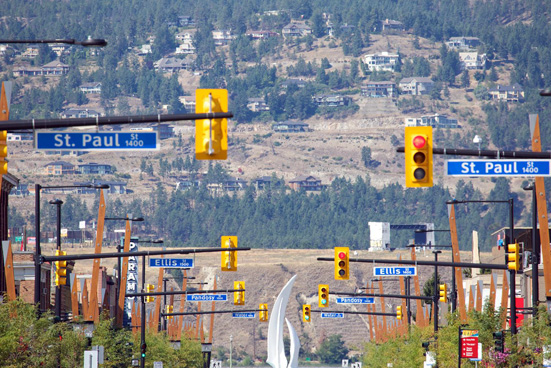Kelowna deploys Blue Chip lidar traffic sensors on 5G
- June 9, 2020
- Steve Rogerson

The Canadian city of Kelowna is launching its first real-world 5G smart city service using road junction sensors as it begins its phased return to normal and residents increase their movement.
The city is working with Rogers Communications and the University of British Columbia (UBC) to install two lidar sensors from Blue City Technology powered by the Rogers 5G network. The sensors will be installed at the intersections of Bernard Avenue and Water Street, and Bernard Avenue and Pandosy Street, with plans for more sensors to go up at three additional intersections later this year.
A smart city uses sensors connected to the internet to collect data and then uses the data to improve the management of assets and resources, such as garbage collection, parking spaces and traffic systems.
In March, nearly 50 UBC students got together as part of a virtual hackathon to explore how technologies and improved wireless connectivity could help the city find ways to improve how people move around downtown and increase pedestrian and cyclist safety through design. It is one of the winning ideas from this hackathon that is being implemented as a pilot project in downtown Kelowna.
“This is an exciting opportunity for Kelowna to build on the work we’re doing to bring smart city technologies to our city,” said Kelowna mayor Colin Basran. “Transportation has always been a top concern for our citizens and one of council’s priorities. As we grow, we need to better understand what these travel interactions look like and how can we ensure the safe management of everyone using our streets, kerbsides, sidewalks and pathways. The hackathon and this pilot project are great ways to discover solutions developed by smart young minds.”
These wireless devices and their infrastructure follow Infrastructure Canada’s Safety Code 6 – Health Canada’s Radiofrequency (RF) Exposure Guidelines.
“5G isn’t just the next G,” said Jorge Fernandes, chief technology officer at Rogers Communications. “It will truly transform how we live and work with new applications that are being built through collaborations with industry, government and universities. We are focused on bringing together the right partners to build a strong 5G ecosystem and this pilot with UBC and the city of Kelowna will serve as a blueprint for the development of made-in-Canada 5G smart city technology.”
Unlike traffic cameras, lidar captures consistent data over the course of a 24-hour period, regardless of changes in lighting or weather, and the resolution of the data is insufficient to capture or reveal identifying details about people or permit facial recognition. The Kelowna smart city project uses these wireless sensors and software from Blue City Technology to collect anonymous data stored securely on Microsoft Azure on vehicle and foot traffic patterns, which will be used by UBC research students to help find ways to improve vehicle, pedestrian and cyclist safety.
This pilot project is part of research being done by UBC through a partnership with Rogers to study 5G applications and develop smarter and safer cities through made-in-Canada products.
“Until now, detailed information about the way cyclists, pedestrians and vehicles move and behave in urban environments has been surprisingly difficult to collect and, importantly, share in real time,” said David Michelson, lead researcher on the project and director of the Aurora connected vehicle test bed at UBC Vancouver. “This is as close to a perfect academic, public sector and private enterprise partnership as one can imagine. None of us could have done this on our own.”
With the support of Blue City, students from UBC will use the data to answer questions about:
- what modes of transportation are being used in Kelowna and where, such as on streets and sidewalks
- where near misses are occurring between different modes of transportation
- how transit users navigate other corridors when arriving at their stop
- how effective are unsignalled crosswalks
- what parts of a block lend themselves best for pick up and drop off, especially with ride sharing coming
- how to increase the knowledge of emergency responders reporting to a crash scene with details about speeds, types of vehicles involved and what equipment to bring to be prepared for a specific incident
“The 5G smart city pilot uses emerging technology to collect real-time information that will make the lives of British Columbians easier,” said Michelle Mungall, minister of jobs, economic development and competitiveness for British Columbia. “This project demonstrates how ingenuity and collaboration can create solutions that allow our communities to be smarter and safer.”
The hackathon and resulting pilot project support Kelowna’s Intelligent City vision to find ways to improve the lives of residents through access to online services, improved connectivity, technological innovation and collaborative problem solving.





